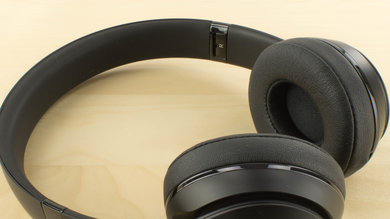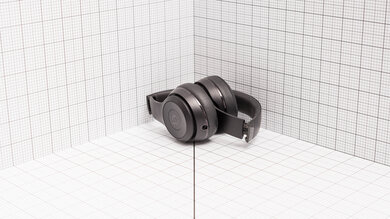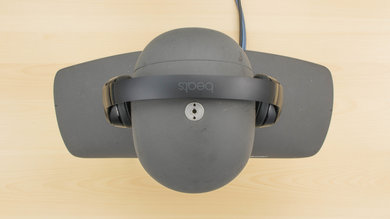The Beats Solo3 2018 Wireless are decent mixed usage headphones with a reasonably balanced sound profile. They're almost identical to the Beats Solo2 Wireless but have a better range and battery life thanks to the W1 chip. They're comfortable but fit a bit tight on the head, so they're not ideal for long listening sessions. Unfortunately, they also have fairly weak noise isolation, so they won't be ideal headphones to use in noisy environments.
Our Verdict
The Beats Solo3 2018 Wireless are fair for mixed use. They're versatile headphones that deliver a decently balanced sound with a slight emphasis on bass. Although they struggle in loud environments, their comfortable and wireless design makes them a viable choice at the gym. The long battery life is also a plus if you're always on the go.
- Sturdy design.
- Excellent wireless range and battery life.
- Poor noise isolation.
- Leaky at higher volumes.
The Beats Solo3 2018 Wireless are satisfactory for neutral sound. Their powerful bass caters decently well to instruments and vocals, although they sound slightly more muddy compared to some other neutral listening models. Unfortunately, due to their small, circular, and closed-back ear cups, they won't have the best soundstage.
The Beats Solo3 2018 Wireless are okay for commuting. They have an efficient and straightforward control scheme. They have a great battery life, and they're also somewhat compact, which makes them a bit easier to carry around on your person. However, they don't isolate well in loud environments, which isn't ideal for commuting or traveling.
The Beats Solo3 2018 Wireless are on-ears, so they may not be the best choice for sports and fitness. While they have a tight fit, they're still bulky and can fall off your head with high-intensity movement. Their ear cups also get a little steamy when exercising for long periods since they trap heat. They lack an IP rating for water resistance, too, but that's to be expected by their design.
Fair for office use. They won't isolate well in a loud, lively office, and they leak a bit at higher volumes, so your coworkers might hear what you're listening to. They have a good wireless range, so if you pair them to your PC, you can walk around in your office. They're also decently comfortable.
The Beats Solo3 2018 Wireless are disappointing for gaming. You can only use them via Bluetooth on PC. However, they have a mediocre microphone and slightly too much latency to be suitable for gaming.
The Beats Solo3 2018 Wireless are decent for wired gaming. These headphones come with an in-line microphone audio cable. While you won't be able to use the microphone when plugged into an Xbox One, you can receive audio. On PS4, however, you can use both the microphone and receive audio.
The Beats Solo3 2018 Wireless are mediocre for phone calls. The microphone has trouble separating speech from ambient noise in moderate to loud environments, while its overall recording quality muffles your voice. You should still be understandable on the other end of the phone, but you probably don't want to be making calls in busy restaurants.
Changelog
- Updated Oct 11, 2023: We've updated the Sports and Fitness verdict and Stability text to improve their clarity.
- Updated Dec 07, 2020: Updated the Case score and text to better reflect its design.
- Updated Feb 13, 2020: Converted to Test Bench 1.4.
- Updated Nov 21, 2019: Converted to Test Bench 1.3.1.
Check Price
Popular Headphones Comparisons

The Beats Solo3 2018 Wireless are on-ear headphones that deliver a well-balanced sound profile. They're wireless and have a great range and battery life, but they can be a bit tight on the head and lack decent isolation for noisy environments.
See our recommendations for the best noise cancelling headphones and the best on-ear headphones.
The Beats Solo Pro are a nice upgrade over the Beats Solo3 2018. They have active noise cancelling, which is very useful in public transit or at the office. However, the Pro are a bit too tight for some, and the Solo3 feel more comfortable. On the other hand, the Pro feel more high-end and more durable. They both have a fairly similar sound profile, but the Pro are a bit more neutral.
The Beats Solo3 2019 are the next generation of the Beats Solo3 2018. They're almost identical in design and perform very similarly. This model also has a companion app that can be used on Android in addition to iOS. That said, the 2018 model includes an audio cable so that you can listen to audio passively. You need to buy this cable separately if you want to use your 2019 model wired.
The Bose QuietComfort 25/QC25 are better headphones than the Beats Solo3 2018. The Bose are noticeably more comfortable, have a better neutral-sounding audio reproduction, and have a great noise isolation performance, which is great for commuting. However, they are wired headphones, so if you prefer a wireless design, then the Beats may be better. They also have more battery life and are rechargeable, while you need to use AAA batteries for the Bose.
The Beats Solo3 2018 are slightly better headphones than the Beats Solo 2. While both headphones have a similar sound profile, the Solo3 have a noticeably better battery life with about 40 hours of continuous playback. They also take advantage of the W1 chip on iOS devices, which the Solo 2 don’t do. Design-wise, there isn’t much difference between the two models.
Test Results

The Beats Solo3 2018 Wireless look indistinguishable from the Beats Solo2 Wireless. You can barely tell them apart, even on closer inspection. The only differences are in the available color schemes: the Solo2 have slightly more options. On the upside, if you liked the previous model, then you'll be familiar with the sleek design and the small, round, and well-padded ear cups of the Solo3. They still stand out in a crowd, especially if you choose one of the flashier color schemes.
The Beats Solo3 2018 Wireless are almost identical in design to the Beats Solo2 Wireless. They have the same weight, and they're just as tight on the head. The ear cups are heavily padded, which makes them decently comfortable, but they aren't ideal for long listening sessions as you may feel fatigued from their clamping force.
The Beats Solo3 2018 Wireless' control scheme is efficient and easy to use. Like the Beats Solo2 Wireless, the buttons feel responsive and are well spaced out on the small ear cup. They provide basic but essential functions: track-skipping, call/music, and volume controls. The buttons are a bit small, but they're not much cause for concern.
The Beats Solo3 2018 Wireless have very good breathability. They have an on-ear design that doesn't fully cover the ears; heat is trapped within the notch and ear canal, leaving the outer ear relatively cool. These headphones can make you sweat a bit more than usual during intense workouts, but they're not as bad as most closed-back over-ear designs.
The Beats Solo3 Wireless come with a good soft case that should protect the headphones from scratches and scuff when they're in your bag. Unfortunately, the soft case won't shield them from impacts or water damage like the JBL Everest 310 Wireless' hard case can.
These headphones are well-built, compact headphones that won't break if you accidentally drop them a couple of times. They're made using high-end materials, and the headband is reinforced with a metal frame that makes them decently sturdy under physical stress. Unfortunately, the plastic coating feels rigid; if you bend them too far, they may crack. The coating is also prone to scratches and scuffs.
The Beats Solo3 Wireless have a stable fit. They have a tight fit, so you can wear them at your desk or on your commute without worrying they'll move around. However, if you want to wear them while working out or running, they can shift in positioning and even fall off your head. Luckily, since they have a wireless design, they won't get pulled off your ears because the audio cable got hooked on something.
Slightly more balanced than their predecessors, the Beats Solo3 2018 Wireless' sound profile leans into the bass, making them a good choice for people looking for a little more thump in their audio. The dip in the mid-range recedes vocals and instruments in favor of the bass, while the treble is prone to brightness. This mix can make the sound profile sound muddy, however. Consider the Status Audio BT One Wireless if you're looking for Bluetooth on-ears with a more neutral sound profile.
These headphones have a good frequency consistency. While the Beats Solo3 2018 Wireless perform better than their predecessor, there are still similar inconsistencies, particularly noticeable in the treble. Depending on how you wear these headphones and how they sit on your ear, you may need to readjust them on your head to get the same listening experience every time.
The Beats Solo3 2018 Wireless' bass accuracy is just okay. The overemphasized bass, while fairly even across the range, produces prominent thump, rumble, and boom. However, some users may find they sound a bit muddy.
The Beats Solo3 2018 Wireless have great mid accuracy. The response is pretty consistent, except for a dip in the mid-mid, which pushes vocals and other lead instruments slightly to the back of the mix and giving more emphasis to bass instruments.
The Beats Solo3 2018 Wireless have impressive treble accuracy. Their good balance of presence, detail, and brightness in the reproduction of vocals, leads, and cymbals make them well-balanced and quite neutral sounding.
The Beats Solo3 2018 Wireless' peaks and dips performance is decent. The peak in the high-bass produces more thump while the following dip between low and mid-mid pushed vocals and instruments back in the mix. Another spike in the low-treble makes sounds in this range sharp or bright.
The Beats Solo3 2018 Wireless have excellent imaging. Their weighted group delay is below the audibility threshold and should result in a tight bass and transparent treble reproduction. Additionally, the L/R drivers of our unit were exceptionally matched in amplitude, frequency, and phase response. This ensures an accurate placement and localization of objects (voices, instruments, footsteps) in the stereo image. However, these results are specific to our unit and may not be the same with every pair.
The Beats Solo3 2018 Wireless' soundstage is poor. Since these are on-ear headphones, they have limited acoustic interaction with the pinna or outer ear, which is necessary for creating a large and out-of-head soundstage. Also, because of their closed-back design, their soundstage will be perceived as less open, compared to open-back on-ears like the Grado SR80e/SR80. Overall, the soundstage is perceived to be small and located inside the listener's head.
The Beats Solo3 2018 Wireless don't have any virtual soundstage features.
The Beats Solo3 2018 Wireless' weighted harmonic distortion performance is excellent. All frequencies fall within good limits, which should result in a clear and pure audio reproduction.
Our Beats Solo3 2018 Wireless results are only valid for these test settings.
The isolation performance is disappointing. These on-ears provide little isolation in the bass range, which means you hear the rumble of airplane and bus engines. While the passive isolation provided by the ear cups starts to kick in towards the mid-range, these headphones still have trouble blocking out most speech. However, sharp sounds from the treble range are reduced. If you like on-ear designs but need a bit more isolation for your noisy commutes, then check out the AKG N60NC Wireless, the Marshall MID ANC Wireless, or even the higher-end Beats Solo Pro Wireless.
The leakage performance is mediocre. These headphones leak a bit more than the usual closed-back on-ear headphones. While leakage is low in the bass range, there's a noticeable spike in leakage in the treble range: to others, your audio sounds thin. If you like to blast your music, people around you in quiet to moderately busy environments, the people around you can hear it.
The Beats Solo3 2018 Wireless have an integrated microphone. The detachable audio cable also has an in-line microphone.
The integrated microphone has a mediocre recording quality. Speech recorded or transmitted with these headphones sounds quite thin, lacking detail and presence. However, this won't have a big negative effect on the intelligibility of the recorded speech.
The noise handling performance of the Beats Solo3's microphone is sub-par. The microphone struggles to separate speech from ambient noise in moderate to loud situations. However, in quiet environments, speech should sound clean and clear.
The Beats Solo3 2018 Wireless have an impressive battery performance. They can last up to 40 hours of continuous playback on a single charge. They also charge surprisingly fast: a 5-minute charge delivers above 2.5 hours of playback while a full charge is complete in less than two hours. If you're always on the go, the long battery life ensures that you can go longer without charging them. However, they don't have an auto-off timer, so the battery will continue draining if you don't switch them off. If you're looking for a pair of wireless on-ears with even longer continuous battery life, take a look at the Jabra Evolve2 65 Wireless.
Like the Apple AirPods (1st generation) Truly Wireless, the Beats Solo3 2018 Wireless also use a W1 chip to provide extra features on iOS devices. These headphones connect with a pop-up that displays basic battery information. Unfortunately, this isn't particularly useful as it only shows up on your initial connection with an iOS device; however, you get live feedback notifications on the battery status. Unfortunately, this feature isn't available on Android. If you're looking for similarly designed Beats headphones that have an app that's compatible with Android devices, consider the Beats Solo3 2019 Wireless.
The Beats Solo3 2018 Wireless connect wirelessly via Bluetooth. Unfortunately, they can't pair simultaneously with multiple devices and don't have NFC support. While they have improved latency compared to their predecessor and have a lower latency on iOS, they won't be the ideal headphones for watching movies or gaming.
The Beats Solo3 2018 Wireless are Bluetooth-only headphones.
The Beats Solo3 2018 Wireless come with an iOS cable with an in-line remote microphone that's compatible with the PS4 but not the Xbox. This gives them a secondary connection option in case you want to save battery life by turning off Bluetooth or if you want less latency while watching videos or gaming.
You can only use these headphones via Bluetooth on PCs. Due to their high latency, however, they aren't recommended for gaming. While you can't use them wirelessly on the PS4, they can be used with the audio cable plugged into the controller: you can receive audio as well as use the microphone.
These Bluetooth headphones are only compatible with the Xbox One while the audio cable is plugged into the controller. However, you can only receive audio and won't be able to use the microphone.
These headphones don't have a base/dock. If you want a versatile headset with a base that you can also use wired, check out the SteelSeries Arctis 7 Wireless 2017.
















